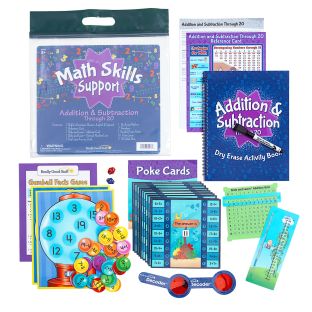Addition & Subtraction – Elementary
Popular Elementary Addition & Subtraction Materials
Inspire engagement with popular Elementary Addition & Subtraction Materials. Our most-purchased Elementary Addition & Subtraction Materials are versatile and appropriate in most school environments.
Really Good Stuff’s top Elementary Addition & Subtraction Materials enhance experiences for students as well as teachers. Shop our most popular Addition & Subtraction Materials for educators.
Elementary Addition & Subtraction Products
Top-Rated Elementary Addition & Subtraction Materials | 2025 School Year
Get top-rated Elementary Addition & Subtraction Materials from Really Good Stuff. Teachers rate these 16 Addition & Subtraction Materials with an average of 4.8 stars, making them the best Addition & Subtraction Materials.
Explore these Elementary Addition & Subtraction Materials loved by students aged 3 to 12 years-old. Through premium Elementary supplies, Addition & Subtraction Materials can help your PreK grade to 8th grade class.
Learn More About Elementary Addition & Subtraction Materials
Enhance your Elementary classroom with Really Good Stuff’s Addition & Subtraction Materials. Our catalog of 53 high-quality Addition & Subtraction Materials start at $8.99 and fit the Elementary classroom. From premium brands like Really Good Stuff® and Carson Dellosa Education®, these Addition & Subtraction Materials meet the needs of Elementary teachers.
Really Good Stuff’s Addition & Subtraction Materials for Elementary students work for ages 6 to 10 and for grades 1st to 6th. Teachers match Elementary Addition & Subtraction Materials with other Addition & Subtraction Materials from the Math category.
Make Really Good Stuff your top choice when looking for Addition & Subtraction Materials for your Elementary classroom.
In the elementary classroom, addition and subtraction are fundamental skills that form the backbone of a child’s math education. Teachers frequently incorporate these skills into everyday lessons using a variety of methods. For example, they might use interactive games, visual aids like number lines and charts, and hands-on activities such as counting blocks or abacus. Additionally, real-world applications, such as calculating change during a “classroom store” activity or tallying scores in group games, help instill these concepts in practical, engaging ways. These diverse teaching methods aim not only to teach the basic operations but also to enhance problem-solving and critical-thinking abilities in young students.
When selecting addition and subtraction products for your elementary classroom, keep these three tips in mind: First, opt for products that are age-appropriate and challenging enough to stimulate learning without causing frustration. For instance, while first graders might benefit from simple counting aids, older students could work with more complex tools like interactive math apps or puzzles. Second, consider versatility and durability—products that can be used in various activities and last through years of use provide greater value. Lastly, stay attuned to products that offer differentiated learning styles, catering to visual, auditory, and kinesthetic learners to ensure that every student has the opportunity to succeed.
Addition and subtraction products are typically used by children from kindergarten through fifth grade, covering ages approximately five to eleven. Each grade level will have different needs and complexities. For instance, kindergartners may start off with basic counting and begin to understand addition and subtraction with numbers up to 10, while older students might work with larger numbers and start exploring concepts like regrouping. When buying products for an elementary classroom as opposed to higher levels of school, it is vital to focus on the developmental learning stages of these younger students. Elementary products should be colorful, engaging, and designed to build foundational skills that will prepare students for more advanced math concepts in later grades. Always look for products that align with educational standards and support a well-rounded approach to learning arithmetic.
FAQs for Elementary Addition & Subtraction Materials
What are the highest rated Elementary Addition & Subtraction Materials?
- Solving Problems Two-Sided Dry Erase Boards Set – 6 Boards (5 stars) – $29.99
- Really Good Stuff® Rock, Paper, Scissors Math Game – Addition And Subtraction Through 1,000 – 1 game (5 stars) – $18.88
- Really Good Stuff® Number Lines 0-10 and 0-20 Dry-Erase Boards – 6 Boards (5 stars) – $29.99
What Elementary Addition & Subtraction Materials do teachers use most?
Can you recommend some budget-friendly Elementary Addition & Subtraction Materials?
- Solving Problems Two-Sided Dry Erase Boards Set – 6 Boards (5 stars) – $29.99
- Really Good Stuff® Number Lines 0-10 and 0-20 Dry-Erase Boards – 6 Boards (5 stars) – $29.99
- Really Good Stuff® Learning Success: Grade 1 – Reading, Math, and SEL (5 stars) – $29.99























